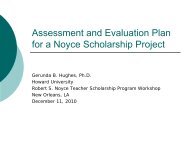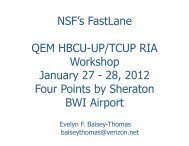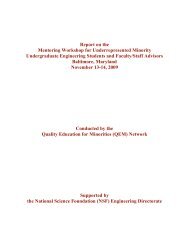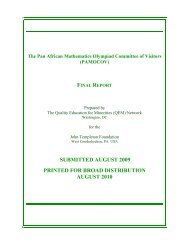Terrell Strayhorn
Terrell Strayhorn
Terrell Strayhorn
Create successful ePaper yourself
Turn your PDF publications into a flip-book with our unique Google optimized e-Paper software.
NASPA Journal, 2008, Vol. 45, no. 1or lower”) to 5 (“A”). Second, satisfaction with college was a compositevariable estimating the degree to which students’ college experiencesmatched their expectations. Student satisfaction reflects “thefavorability of a students’ subjective evaluation of the various outcomesand experiences associated with education” (Elliott & Shim,2002, p. 198). Following recommendations provided by Gonyea et al.(2003), I calculated a composite variable using two items from the collegeenvironment scale of the CSEQ (alpha = 0.67). An example of oneitem is, “If you had it to do over again, would you attend the sameinstitution?” Responses to each item were placed on a 4-point scaleranging from 1 (“no, definitely”) to 4 (“yes, definitely”). Added together,the composite variable ranged from 2 to 8 with higher scores indicatinghigher levels of satisfaction with college. This procedure is consistentwith suggestions offered by Pace (1984) and Gonyea et al. forassessing student satisfaction in college using the questionnaire.The main independent variable was operationalized using 14 itemsfrom the survey. Items measured the availability of a strong supportperson in various situations and circumstances (Sedlacek, 2004). Anexample of one item is, Talked with a faculty member or staff memberabout personal concerns. Response options for this single item rangedfrom 1 (“never”) to 4 (“very often”). To test the underlying structure ofthese 14 items that were purported to be related to each other, I conductedfactor analytic tests. Results of a principal components factoranalysis, with varimax rotation, revealed that items loaded on a singlefactor, which accounted for approximately 46% of the inter-item variance.Thus, the items were combined to create a single composite variable(alpha = 0.89) ranging from 14 (“never any support”) to 56 (“veryoften, a lot of support”). Table 1 presents the model’s specification.Data AnalysisData analysis proceeded in three stages. First, descriptive statisticswere used to calculate means and standard deviations for all independentand dependent variables included in the analysis. Second, ordinaryleast squares regression tests were employed to measure thesimultaneous relationship between “supportive relationships,” academicachievement, and satisfaction with college among AfricanAmerican men. Finally, hierarchical linear regression tests were conductedto test whether statistically significant linkages between sup-32
















